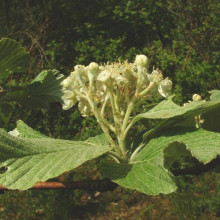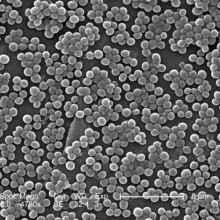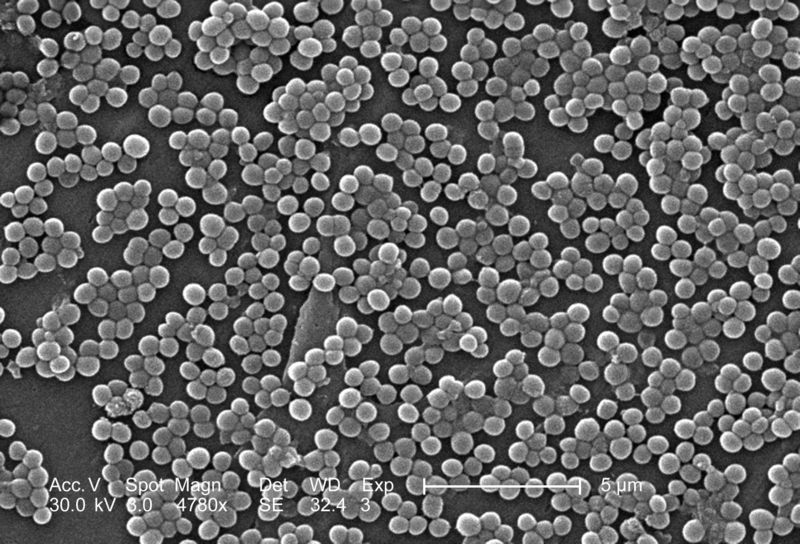Can Gravity Leak from Alternate Universes?
Why does biro ink smell? How can you reset your tolerance to caffiene? Why can't my sat nav and my speedometer agree? We take on your science questions, as well as discover a lonely rogue planet and hear the DNA detective story that stopped an MRSA outbreak in its tracks. Plus, in our Question of the Week, we find out if menstrual cycles synchronise...
In this episode

- Light at Night Can Harm Your Memory
Light at Night Can Harm Your Memory
Being exposed to bright lights at night could harm your health and your memory - even if you think you are sleeping normally...
Tara LeGates and her colleagues from John Hopkins University, Baltimore, exposed a group of mice to an alternating pattern of 3.5 hours of bright light followed by 3.5 hours of darkness over a 2 week period. This produced no change in their sleeping pattern, the overall length of time they slept for, or the levels of hormones that usually change at different times of the day.
But it did make the mice depressed, and reduced their abilities to form new memories. Depressed mice demonstrate behavioural signs, such as lower preference for sweet things. This can be an indicator of 'anhedonia'- the inability to feel pleasure, which is a symptom of depression in humans. Depressed mice also "give up" on certain tasks more readily, like poorly motivated people.
Humans with depression also often complain of memory problems. These mice were the same, establishing new memories less well than control animals.
This experiment meant that when the mice - which are normally nocturnal - were waking up to become active in what should be night-time, and dark, they were actually being exposed to light. And this - being exposed to light when the brain is not expecting it - the researchers think, is what made the mice depressed.
LeGates and colleagues, writing in the journal Nature, think that it's down to specialised light-detecting cells in the eye called intrinsically photosensitive retinal ganglion cells. These cells don't help animals to see but instead they detect when it is daytime or night-time, and they're used to set the brain's internal clock circuitry that enables animals to know when it's time to wake up or to go to sleep.
But, the researchers found, these cells also send signals to the parts of the brain concerned with mood and memory. And being exposed to light at the "wrong time" - so in the case of the mice, when they were awake and expecting it to be dark; for a human this would be the equivalent of working late at night in front of a bright computer screen - abnormally triggers these mood-related brain areas, causing depression, probably by provoking increasing the levels of the stress hormone cortisol.
Humans have the same light-sensitive cells as mice, so there is no reason to think that this couldn't apply to us. It is something important to bear in mind particularly for those who undertake shift- work, or regularly who work on computers late at night. So ignore your bed time and leave the lights on at your peril!

What determines hair colour?
Ginny - Well, the keratin that makes up the structure of your hair is actually white, so it's all about these two different types of melanin which are the pigments that gives your hair colour. There's eumelanin which can be black or brown and there's pheomelanin which is sort of a reddish, yellowish colour. It's the proportions of each of those that make your hair a different colour. So if you've got brown hair, you've got lots of eumelanin and not as much pheomelanin. Blondes will have any real proportion of the two, but not very much of either of them and red heads have a lot more of the pheomelanin and not so much of the eumelanin.

Do Parallel Universes exist?
Dominic - That's an interesting one because there's certainly a lot of scientific talk about parallel universes, but they're impossible to observe because by definition, everything we see around us is in our universe. The reason why theorists sometimes talk about them is because you can make neater, simpler theoretical models of the universe we have, if those models also predict the existence of other universes that maybe have different laws of physics. For example, our universe has complexity in it as a result of galaxies and stars collapsing at a balance between gravity and gas pressure, and that means those two forces have to be in a very fine balance. If they weren't in fine balance, we wouldn't have complexity in our universe. We wouldn't be here. So why is that balance there? Well, perhaps it's because there are other universes that have much simpler and less interesting laws of physics.
Chris - So there are lots and lots of different universes where the rules or the parameters may be slightly different and we're here, just because we happened to be in the one for which that physics works for us.
Dominic - That's a very controversial idea, but that would certainly be what Martin Rees for example would say.
Chris - So Catherine, Dominic has explained that we may just be one of many. I guess you'd also quite like to know whether or not we can detect them if they are there.
Catherine - Yes, definitely, yes.
Dominic - That's really quite difficult because all of the light that we see is traveling through our universe. There have been some bits of theory that have predicted that perhaps there could be interactions between parallel universes objects like white holes and worm holes that the problem is those are really speculation at the moment. So I don't think there's any imminent prospect of us getting any evidence for them.
Chris - Michio Kaku has got quite a good book called Parallel Universes and in there, he talks about the fact that because we believe gravity should be able to propagate between these different universes if they exist, that detecting the gravity waves coming from one into the other may be actually the way to infer their existence. There are various experiments that scientists are doing to look for gravity waves, aren't there?
Dominic - That's right. There are several experiments looking for gravity waves and I think it is likely we will detect them in the next 5 to 10 years. And that will be very exciting because we have many competing theories of gravity all extending Einstein's general theory of relativity and it will be gravitational waves that will really distinguish between those and tell us what we're looking for.

04:45 - The Naked Scientists Mexican Twitter Wave
The Naked Scientists Mexican Twitter Wave
with Ben Valsler, The Naked Scientists
We investigate the power of social media by attempting to create a global Mexican Wave across twitter...
We've archived the tweets here, and you can see a map of their distribution here.
The following map, put together by Barney Brown, Petra Vertes, Naaman Tammuz and Tom Hennigan shows links between people retweeting our initial post...

Could dark matter be leaked gravity?
Dominic - That's an interesting and rather topical question actually. We don't have a good idea at all what dark matter is. We can only see its gravitational influence on other objects in the universe.
If you look at galaxies and you measure how fast those galaxies are rotating and estimate how much mass is in those galaxies, you'll realise that they should really spin apart because of a centrifugal force. There must be some gravitational glue in there, sticking that galaxy together and that mass isn't producing any light, so we call it dark matter. But we have very little idea what that mass is.
We've had some theories and one of the leading theories, up until a few weeks ago was particles that particle physicists call supersymmetric particles. But you may have seen in the news in the last few weeks, the latest news from the Large Hadron Collider is that those supersymmetric particles probably don't exist. So I think we're back to the drawing board actually in trying to work out what dark matter actually is.
Chris - It's a tough one, isn't it because we know it's there. We can see its effects, but we have no idea how to actually start trying to measure it.
Dominic - That's right. I think the evidence will come from experiments like the Large Hadron Collider. This is almost certainly some new kind of particle that we don't actually know yet about, but which I'm sure we would discover at some point.

Why do feet smell?
Sharon - I'm no expert on smelly feet, I have to say, Chris! But the way that you smell is often down to the way that your bacteria metabolise the organic matter that's actually secreted from your body. So for example, smelly armpits and smelly feet are due to bacteria breaking down components of the body's secretions. And so, it is down to that I'm afraid and perhaps washing your feet to get rid of the bacteria might be good.
Chris - Why feet specifically rather than other bits of the body?
Sharon - Well, that's interesting. I'm not sure I know the answer to that.
Chris - Stewing in trainers, lots of sweat, dead skin?
Sharon - Yes, I think old trainers probably have a lot to do with it. Certainly, new trainers don't seem to smell as bad as old trainers, so I'm no expert on smelly trainers, but I think that you could say that it's down to the flora, the bacteria that are on your feet.
Chris - Sharon, thank you. So, basically, it's down to the microbes that are living on you and in between your toes, and they're consuming the dead skin that you're turfing out. I think it's something like 40,000 skin cells a minute that leave the body. It's 1½ stones in dead skin over a lifetime that we accumulate, just dead skin that we slough off into the environment. Then there's all of the sweat that we squirt out. I think it's 1½ litres of sweat a day that gets squirted into your socks. You sort of cook up this lovely bacterial banquet in your shoes. And because the air can't circulate, the bacteria do flourish and some people will have smellier feet than others.

10:19 - Can I reset my tolerance for caffeine?
Can I reset my tolerance for caffeine?
Ginny - Caffeine is used by so many people to keep them feeling awake. It's probably one of the most commonly used drugs, but it actually works by countering a substance in your brain known as adenosine. This builds up during the course of normal brain activity. There are receptors to monitor the amount of the substance and that's how your brain tells when it's coming to the end of the day, and you should maybe be getting a bit sleepy and thinking about going to bed.
Now caffeine is really clever because it looks quite similar to one of these adenosine molecules so that it actually fits into the receptors, but doesn't activate them.
So because the receptors are then blocked by the caffeine molecules, your brain is tricked into thinking there's less adenosine there and so, you don't get the feelings of sleepiness and that allows your brain's natural stimulants, the dopamine and glutamate molecules to work freely without being inhibited.
The strength of these effects can vary from person to person and it depends on loads of different factors, but partly, it's their level of tolerance. As with all drugs, continued use of caffeine does build up this tolerance. So, the first time you have a cup of coffee, you probably feel its effect very strongly, but if you've been drinking 5 cups a day for 10 years, you'll probably stop feeling the effects at all and actually, just need it to get back to a normal level. You can think of tolerance as the brain trying to get back to what it was like before you started drinking caffeine. So, if you push it in one direction, it's going to try and push back in the other direction. But that then means if you take away the caffeine, your brain is then too far the other way and this is where you get the withdrawal symptoms which can be quite extreme.
Chris - Headache.
Ginny - A lot of people get headaches, but you can also get nausea, you can get irritability, all sorts of horrible things. This tolerance can build up really quickly, actually between 1 and 2 weeks and can be really strong. So, even very high doses of caffeine can start not increasing your alertness after only 18 days or so.
Chris - There was a chemist in Glasgow University who did a study where he wants to know how much caffeine was in the coffees being served up at the average coffeehouse. If you go and buy a pack of cigarettes for example, they tell you how much nicotine there is in cigarettes. If you go and buy an alcoholic drink, it would tell you how much alcohol there is in it. You can go to any coffee chain and buy a coffee, but it doesn't tell you how much caffeine is in there.
This is important because there are risks to health for certain groups. Women who are pregnant - it's been shown - should probably try to keep their caffeine intake down below about 2 cups a day because any more than that can actually be associated with miscarriage.
And this gentleman found, by going into a number of - I think more than 20 - coffee shops in Glasgow, ordering an espresso and then immediately taking it outside, putting it in methanol and then freezing it in his lab to preserve the caffeine, he found that there was anything between 50 micrograms of caffeine which is the equivalent of a reasonable strength coffee up to 300 from one coffee shop! So that's the equivalent in just the same beverage of having 6 cups of coffee in one go from one store and just three in another. It's amazing, isn't it? It's incredible dosage!
Ginny - Wow, that's a huge difference.
Chris - So what should Ari do then? Should he ditch the coffee?
Ginny - Well sadly, the only way to get over this tolerance that I've found is to stop drinking the coffee. There are people who say it's better to go cold turkey and you may feel a bit rubbish for 10 days or so, but then it will get better. Other people say it's better to bring it down gradually. I think that's up to you, but the only real way to get over it seems to be, to stop it so that your brain can recover.

15:05 - Sex in Sorbus Species - Planet Earth Online
Sex in Sorbus Species - Planet Earth Online
with Professor Simon Hiscock, University of Bristol & Mandy Leivers from the Avon Gorge and Downs Wildlife Project
Best known for Brunel's Clifton Suspension Bridge, the Avon Gorge in Bristol, southwest England is also home to several unique species of plants.
Some tree species here - varieties of sorbus - are found nowhere else in the world and have evolved through an unusual reproductive process.
Planet Earth Podcast presenter Richard Hollingham clambered down a steep path into the wooded gorge to talk to Mandy Leivers from the Avon Gorge and Downs Wildlife Project, and Simon Hiscock a Professor of Botany at the University of Bristol.
Richard started by asking Simon how to spot a sorbus tree...
Simon - Its common name is white beam because of the colour of the leaves in the spring. They are members of a big family - the rose family - rosacea.
Richard - So point some out to me. Where is one?
Simon - Just up there, there is one of the rare ones that we only find in the gorge, Sorbus bristoliensis, and also over here Sorbus wilmotiana, which is another endemic to the gorge.
Richard - So they are spindly trees and the leaves at the top-
Simon - The leaves are quite pale-ish up at the top and they are falling at the moment and they have this white tinge which is much more pronounced in the spring when they first come out.
Richard - So what is special about them? What makes them different?
 Simon - Well, what's special about the ones in the Avon Gorge is that we've got a process of evolution going on here that is constantly generating new genotypes, new species through processes of hybridisation. This is when two distinct either species or micro species cross pollinate to make hybrid seed. The hybrids reproduce principally by a sexual reproduction making seeds without sex and then every so often there's a leaky bit of sex involved back crossing to one of the sexuals or to another form and this then generates hybrids which are then maintained by asexual reproduction so it's a very fluid process.
Simon - Well, what's special about the ones in the Avon Gorge is that we've got a process of evolution going on here that is constantly generating new genotypes, new species through processes of hybridisation. This is when two distinct either species or micro species cross pollinate to make hybrid seed. The hybrids reproduce principally by a sexual reproduction making seeds without sex and then every so often there's a leaky bit of sex involved back crossing to one of the sexuals or to another form and this then generates hybrids which are then maintained by asexual reproduction so it's a very fluid process.
Richard - So, Mandy, in terms of the area here, not just the individual species, how important is this in terms of conversation terms?
Mandy - Well, the Avon gorge is considered to be one of the top three sites for rare plants in England. There are 27 nationally rare and scarce plants that grow here, so it is internationally important as a special area of conservation and also nationally as a Site of Special Scientific Interest.
Richard - I have to say it doesn't look - it's pleasant, but it doesn't look particularly special.
Mandy - Well, a lot of the plants that grow here have been growing here for a very, very long time and most of them are very, very small. The white beams are really an exception. So things like the Bristol onion and the Bristol rock-cress which just grow here and nowhere else in the rest of the country, but they all belong to a community of limestone grassland plants and that's what's particularly important about the Avon Gorge.
Richard - What difference has it made having science underlying the work here?
Mandy - It's always been very traditional for conversationalists to just go out and remove bramble, ivy and trees if they're threatening grassland plants and we've been working with the University to look at how science can help us make better decisions when we're managing the area.
Simon - So the curious finding that we've made is that these new hybrids, which can be different numbers of chromosomes compared to the parents, although they're reproducing asexually, producing seeds without sex, they do need pollination in order to drive and trigger the asexual formation of seeds. So this is quite curious and we've found that among the rare hybrid species like Sorbus bristoliensis and Sorbus wilmotiana, this is being driven not by their own pollen buy by pollen from another species particularly Sorbus aria the original parent. So these asexual plants, these rare plants need to be pollinated by another Sorbus in order for them to set their asexual seed. It's very complicated but the key finding is that Sorbus aria is important for providing the pollen that triggers the asexual seed set. So we've got to preserve enough Sorbus aria in the gorge, even though it's very, very common, we've still got to look after it in order to drive the reproductive process of the rare endemics and further their survival.
Richard - So they're all still interlinked even though they're separate species?
Simon - Yes. This is a new idea in conservation and wild life management with these plants is that you preserve the process rather than necessarily rare plants themselves.
Why do blue biros smell salty to me?
Chris - I don't think they necessarily smell salty, but I know what she means because if I scribble with my pen and my bit of paper, there is a distinctive smell.
Biros are actually quite clever. They're really a feat of amazing engineering. They consist of a little ball in the end of the biro and that is rolling around freely and connected to that straw-like structure inside the pen which has got ink in it. The ink has just the right viscosity or thickness so that when the ball rolls around, a thin layer is plastered over the surface of the ball. The ball goes around a bit further, transfers or prints that ink onto the page, leaving a line and then rolls around a bit further and picks up more ink. Now to get that ink to behave in that way, you've got to have just the right runniness and then be very quick drying. They do that using chemicals which are called solvents and one of them is called polyethylene glycol. It's the same stuff that you put in anti-freeze and it makes things runny, but it evaporates very quickly. It has quite a strong sweet odour. So, there are a number of these solvents, one of them being this anti-freeze-like molecule.
So I suspect what Grace is smelling is one of the solvents as she writes with her pen. And lots of pens use a similar thing. If you use a felt tip, they haven't got a ball in them, but they've still got ink which has got solvents. So things that dissolve ink in with molecules and when you draw a line on the page then the solvent evaporates, leaving behind just the ink molecules stuck into the page surface.
Dominic - Is it safe to be smelling that solvent?
Chris - Well, in the concentration you'll get from a Biro, I don't think there's too much risk. It's more dangerous what you write with the pen than what you'll find actually contained in the pen.

Why don't my sat nav and speedometer agree?
Dominic - It's partly a safety measure that car speedometers tend to read a little bit on the high side. That means if there's any slight uncertainty in exactly how accurate that speedometer is, if you're driving along in a 40 mile/hour speed limit balancing your needle on 40 miles an hour, at least you've got a pretty good idea that you're not speeding. You might be doing a bit under 40, but you're not actually breaking the law. There's also some uncertainty because the car doesn't know exactly how big the wheel of the car is. It only knows how fast that wheel is rotating. If your wheel is slightly bigger then it's got a bigger circumference to that wheel and you'll be traveling further for each rotation of that wheel.
Chris - In other words, when you've put in new tyres on the car, for example, then the wheel is actually going to go further for each rotation than when the tyres have worn down, and for that reason, the speedometer doesn't know whether the tyres are new or old.
Dominic - Yes, so to err on the safe side, it will assume that you've got the biggest possible tyre that you might have, and maybe even slightly bigger than that by 5 to 10%. Whereas the satnav system, it knows exactly where you are on the surface of the Earth. It can work out exactly how fast you're traveling, and so that will tell you exactly the right speed...

How did our ancestors make wine?
Chris Smith answered this question...
What an excellent question! So what you're saying is that, these days, when we try to make beverages, then if we're not careful, they end up contaminated and spoiled. The answer is, it's the same when they used to make beer. In fact, people used to drink a lot of beer in Roman times. It wasn't the high strength stuff we have today but because the water was so contaminated, the wine and the beer were better to drink because they were less likely to be contaminated because they had alcohol in them. Basically, if you take grapes and just pick them off the vine and you have relatively good clean starting water, what you're actually relying on is not having sterility in the system because the yeast all comes from the grapes in the first place. If you've ever picked fruit - you might have noticed this, Les - if you look at the surface of a fruit, unless you buy it from a supermarket - what does the surface of a picked plum or some grapes look like if you look at them?
Les - It's got a little bloom to it usually, almost a coating effect, I suppose you could say.
Chris - That's right, and if you were to take some of that coat and then put it under a microscope, what you would see is that that's mainly yeasts. So there are microorganisms there, but there are lots of yeasts in particular naturally on the fruit. If you put those into ideal conditions so the yeast can start to grow, and what the yeast is going to be doing is to consume the sugars in the fruit. If you do it without oxygen being there, it's going to convert the sugar into alcohol and some carbon dioxide. Because there's so much yeast there, pretty quickly it will outcompete the other things that shouldn't be there and it will supress their growth because the alcohol they produce is toxic to the other organisms. The yeast can tolerate it though and so, the yeast outgrows other microorganisms. You end up fermenting the wine and you make a high alcohol or relatively high alcohol beverage where you've used the alcohol actually to supress the harmful microorganisms. This means it's effectively self-sterilising.

Why do we usually sneeze more than once?
Ginny - I tend to only over sneeze once, but my boyfriend always sneezes 3 or 4 times every time he sneezes. It's quite interesting, different people do seem to sneeze differently.
Sneezing is a reflex that occurs in response to a stimulus, some kind of irritant, something annoying, entering the nose. It's semi autonomous which means that although it is a reflex, we do have some control over it, so you can sometimes manage to stifle a sneeze, but it can be quite tricky to do that. So, it can be a normal irritant like dust, pet hair, some kind of virus or microorganism. But in many people, including me actually, sneezing can also be triggered by bright lights. So if you go out into the sun.
Chris - Ah, the photic sneeze reflex!
Ginny - Yeah, exactly.
Chris - Yeah, we've talked about that before.
Ginny - [Non-photic] sneezes are triggered when a particle of some kind makes contact with your mucus membrane and then that sends a signal to your brain and the response is this very dramatic sneeze which actually uses a whole load of different muscles because you need some muscles to brace yourself against it. Otherwise, you go careering across the room when it happened.
It doesn't really seem to be understood why different people sneeze differently. There may be a genetic component, there usually is to these things. I found one thing that said that it may be more common in allergenic individuals, so people who are responding to chronic irritants - irritants that are there all the time. So if you've got hayfever or if you've got pet allergies, you may be more likely to sneeze lots of times in a row.

31:32 - DNA Sequencing Stops MRSA Spread
DNA Sequencing Stops MRSA Spread
with Professor Sharon Peacock, University of Cambridge
This week, the journal Lancet Infectious Diseases included a rather unusual detective story - one where rapid DNA sequencing was used in a hospital to track an outbreak of MRSA down to one unsuspecting carrier. It bears all the hallmarks of good television forensic crime drama, but it actually took place right here in Cambridge, and the research paper they released is said to be the first example of using this technique to bring an infection to a close.
Chris - The author of that study is Professor Sharon Peacock from Cambridge University. She's with us. Hello, Sharon.
Sharon - Hello, good evening.
Chris - Why did you do this?
Sharon - We want to control MRSA transmission, the passing of it from one patient to another, as much as possible because we want to contain any infections that might arise. And so, we need to see when MRSA does move from one person to another and we need to see it fast.
 The way we do that at the moment is we work out whether two patients who are MRSA positive could've got it from each other because they're in the same ward at the same time. But what we can't do at the moment is to do any sort of typing on the bacteria to see how related the two are.
The way we do that at the moment is we work out whether two patients who are MRSA positive could've got it from each other because they're in the same ward at the same time. But what we can't do at the moment is to do any sort of typing on the bacteria to see how related the two are.
If we had a tool where we could see that they're were either related or unrelated, that would be very helpful because we could work out if transmission had occurred from patient A to patient B, but those tests aren't available at the moment and that's a problem for us.
Chris - So, we know that the two patients have got MRSA, but there's more than one form of MRSA, at a molecular level, so we don't know whether they've come into the hospital independently with their infection or something in the hospital is transmitting these infections between these individuals.
Sharon - That's exactly right. You can't see the transmission pathways between patients. So, what this new technology does is to actually sequence the whole genome with the bacterium.
Even just a few years ago, sequencing a bacterial genome would've cost hundreds of thousands of pounds and taken several years to do a single one. There's new technology now available which allows you to do sequencing of multiple genomes within a day actually, very, very fast and the price has actually fallen very rapidly. That means that we can bring this technology to clinical practice quite soon. In this research study, we really wanted to test out how useful that could actually be in trying to understand better an MRSA outbreak on our Special Care Baby Unit at Addenbrooke's Hospital.
Chris - Can you talk us through how you actually did the study? What were the steps and how did you investigate what was going on?
Sharon - Well, we had access to this technology and we knew that there was a suspected outbreak of MRSA on our Special Care Baby Unit, which should be investigated by our infection control team. Now, they were not sure whether an outbreak had occurred over an extended period of 6 months. There were cases coming into Special Care who were MRSA positive, but we weren't sure if they were related. And the reason for that is because throughout that 6 months, there were quite large gaps when there were no people who were MRSA positive at all. And so, one has to ask, how has that transmission gap been closed?
So, what we did in the first instance was, we took all of those isolates and we sequence them, and we're able to say very quickly that they were all so related at the genome level that this had to be an outbreak. At the same time we extended our search to look for bacteria that are coming from GPs actually in outpatient departments. We sequenced those and we found that actually, the outbreak was twice as big as originally thought and that there were cases actually in the community, people had developed infections. We really only linked that to the Special Care Baby Unit through the sequencing.
Chris - So that meant that you were then able to say right there, there are outbreaks occurring. How did you then go and find the individual that was causing those outbreaks?
Sharon - Well, having identified that there was definitely an outbreak, we put the Special Care Baby Unit under very close surveillance to see if new carriers or people infected with MRSA popped up. Actually, 2 months after the previous MRSA carrier, we found a new MRSA carrier, an infant, and we were puzzled by this because there's obviously a very long gap when we saw no MRSA at all. And it was at this point that we thought there must be a carrier amongst a member of staff.
And so, we gathered the staff together and got full agreement that they would be swabbed and we saw with 154 staff members, we found just 1 that was a carrier. And so, of course we immediately sequenced that and it was a direct match to the outbreak strain. What we think is that this person was involved in the outbreak. What that allowed us to do was to actually treat that individual so that the MRSA carriage is removed from them and that effectively stopped the outbreak from continuing any further.
Chris - How do you know that they gave it to the kids and not the other way around?
Sharon - I think that it will be difficult to be absolutely unequivocal about that individual causing spread throughout the entire outbreak, but what we did do with the staff carrier was we sequenced lots of single bacteria from their carriage population and we got genetic matches to before the 2-month gap and after the 2-month gap. We think that that is fairly strong evidence actually that that person was at least involved in that transmission event.
Chris - This is obviously extremely helpful in terms of guiding infection control strategies, but are there any other uses for this sort of technology in guiding how we tackle bugs of all kinds in the hospital?
Sharon - I think actually that there'll be numerous applications for this. We'll need to work out exactly where, when, and how to use it, but for example, it could be really key in investigating the food-borne outbreaks to work out if there is an outbreak and to help contain that. We could use it for example to get rapid drug susceptibility testing for people with tuberculosis. So, there is a very wide range of applications for this technology and I think that we will be seeing this brought into use in the next few years.

Do pilots consider Earth's rotation?
Dominic - That's a fascinating idea, isn't it?
I always like the idea that perhaps you could take off in a helicopter in London and just float in the air for 6 hours or so and then descend and land in New York, and that would be a very cheap and easy way to cross the Atlantic.
In fact, any aircraft is traveling through the Earth's atmosphere and the Earth's atmosphere is moving with the rotation of the Earth.
Unfortunately, the air that the aeroplane is travelling through is also rotating. You don't have to take any special account for the fact that that the Earth is rotating because you're being carried with that medium.
This is because there is friction between the air in the atmosphere and the ground below.
That friction will start the air rotating with the Earth. At the top of the atmosphere, there's no friction there with space because there's nothing above the atmosphere. So, with time, the atmosphere just picks up the Earth's rotation.

Does testosterone create gender bias?
Ginny - The sex of a baby is determined by whether the egg which is carrying an X-chromosome is fertilised by a sperm carrying another X which will produce a girl or one carrying a Y-chromosome which produces a boy. So, in that sense, it's the sperm that decides the sex of the baby. But what determines which sperm is the first to reach and fertilise that egg or which sperm were even in the mix is a lot more subtle and less well-understood.
Chris - Because the Y-chromosome is likely smaller than the X, some people have argued that they are less of a weight burden for the sperm to push along when it swims and therefore, the Y ones move a bit faster than the X ones. So, depending on when how you time the exposure let's say, you could have a boy or a girl.
Ginny - There is actually a bias, I think it's a 51 to 49 ratio (boys to girls) which fits with that idea that the Y-chromosome sperm is slightly faster, but there are other things that can skew that. Studies seem to show that men with lower levels of testosterone are more likely to produce female offspring and those with high levels are more likely to produce male offspring. So for example, they found that men with prostate cancer which is very strongly linked with high testosterone levels tend to have more male than female children. On the other hand, men who have fertility problems due to lower testosterone tend to produce females when they do father a child. There was even a study conducted at the University of Glasgow that showed that males who ran further than 30 miles a week at the time of conception are much more likely to produce females. If you do a lot of exercise, that tends to temporarily deplete testosterone levels. So, if conception happens relatively soon after the run, then they tend to be more likely to produce females whereas people who were doing just a little bit of running didn't show that difference at all. Chris - So the bottom line is.
Ginny - Low testosterone levels in a male and you're more likely to have girls, but it's very slim differences. Only when you look at hundreds of men proportionally, I don't actually think that going out for a jog beforehand will make you more likely to have a girl.
What happens when we become scared?
Ginny - When something scares us, a signal is sent to our amygdala which is a part of the brain that controls emotion. The first signal that's sent actually bypasses the conscious part of your brain and that explains why if you glance at a piece of rope out of the corner of your eye, you get scared before you consciously see it and realise that it's not actually a snake. It is just a piece of rope, but that fear comes before that realisation. And the second response, because it's slower, travels through the cortex and that gives you the conscious control and the realisation of, "Oh, it's just a piece of rope. It's not going to hurt me."
Now, if it had been a snake you had seen, the feeling of fear would've also been accompanied by what's known as the 'fight or flight' response, and that prepares you to respond to danger.
Your sympathetic nervous system becomes activated and this releases adrenaline into the bloodstream. Your pupils dilate, allowing more light into your eyes, your heart rate and your breathing increase, sweat is produced and digestion stops. Cortisol, which is known as the stress hormone, is also released and this increases glucose levels in your blood to provide extra energy, and all of these things that will prepare you to either run away from the source of the fear or to attack it, to fight back. Now, in modern life, those two options aren't always possible. If the source of your fear is a big presentation at work or something like that then running away or fighting it aren't really possible options.
Chris - You wouldn't get the promotion.
Ginny - No, exactly. So, in this case, these mechanisms which evolve to protect us may actually be detrimental to our health. Prolonged stress responses - so if you stay at this heightened level of arousal, of fight or flight for a long time, it can actually weaken your immune system and increase your blood pressure, so it can make you more susceptible for colds and flus, and also increase your risk of heart attack. So if you do have a very stressful job or life, or you get scared a lot, it's probably a good idea to try and take a break every now and again, let your body calm down a bit and recover.
Chris - What happens if you got to go on the radio and do a radio interview?
Ginny - Well, short levels of this stress is actually quite beneficial. It can actually make you perform better. A lot of performers find that if they don't get a bit of nerves before they go on stage, their performance suffers. There's this inverted U-shaped curve. So, there's a beneficial level and then if it goes above that, it starts being detrimental again. So a short burst, that can be good, but what you don't want is to stay at a very high level of adrenaline release for a very long period of time.
Is the gas in gas giants highly compressed?
Dominic - Well, planets like Jupiter certainly do have cores. Jupiter, we think, has a rocky core that's about 10 times more massive than Earth. Jupiter itself is a really vast planet. It's got about 300 times the mass of Earth and about 10 times the radius of the Earth and most of that volume, most of that mass is a mixture of hydrogen and helium gas. That gas is very heavily compressed and that's how Jupiter manages to be so very massive.
Actually it is in a state called metallic hydrogen, where these molecules are so compressed together that they form a lattice and the electrons, rather than orbiting around individual hydrogen nuclei, actually can flow freely through that metallic hydrogen. That's why Jupiter has such a strong metallic field - because the electrons flow through the hydrogen producing that electric field.
Chris - How did it get all of that gas in the first place? Hydrogen and Helium being so light, how did they manage to coalesce around Jupiter before it got big and had all of that gravity?
Dominic - That's an interesting question that people are actually still researching. But I think that the best theory at the moment is that when a planet gets to a mass of ten times that of the Earth, it's gravitational field is then so strong that it can pull in gas around it and you can get this sudden catastrophic fall of material onto this planet. So any planet that is less than ten times the mass of the Earth will tend to be rocky, like the inner planets of the solar system. Any planets that creep over that mass suddenly turn into these vast gas giants like Jupiter and Saturn.

53:19 - Do menstrual cycles synchronise?
Do menstrual cycles synchronise?
We put this question to Dr Jo Setchell, biological anthopologist at Durham University.
Jo - Menstrual synchrony is a fascinating topic. Lots of women will tell you that they have experienced it, that when they were living with other women, for example as students, they started to have their menstrual period at the same time. However, menstrual synchrony is also a controversial topic. In fact, although there are some very well-known studies that claim to show that it happens in humans, and in laboratory rats, and even some that claim to demonstrate that the synchrony is caused by "pheromones", these studies have all been strongly criticised for the methods used. In fact, if you use correct statistical methods then you find that there is no evidence for synchrony.
I've been studying mandrills - large forest-dwelling primates - for years, and we have records of all the female cycles. A big advantage of these primates is that the females have big swellings around their fertile period, so it's easy to track their cycles (unlike with humans!). When we looked to see whether female cycles are more synchronous than expected from a chance distribution, using some neat statistical modelling, we found that they're not. That's even though if I look at the data, I think you can see patterns!
So, the evidence suggests that, although it's a very appealing idea, cycle synchrony actually has more to do with our evolved ability to detect patterns where there are none than it is to do with real evolutionary forces. We're more likely to notice incidents when we cycle at the same time as a friend than we are to notice when we don't. So you can think of it like seeing faces in the clouds. And why do we do that? Well, because it's always better to spot a predator that isn't there than not to spot one that is!
Hannah - That was Jo Setchell debunking the myth that menstrual cycles synchronise and offering up an evolutionary explanation for why humans identify patterns when they don't actually exist.









Comments
Add a comment